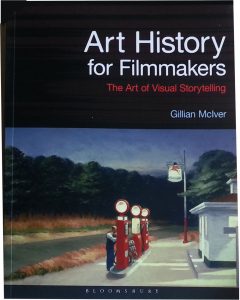
Read the book ‘Art History for Filmmakers’ by Gillian McIver. Bloomsbury Press 2016; available at all good bookstores and online
paperback and ebook from Bloomsbury
by from Amazon UK | buy from Book Depository| buy Ebook from Hive UK
Buy from Amazon US
Buy from Amazon Canada
Some reviews of the book ‘Art History for Filmmakers’
| “Filmmaking does not exist in an artistic vacuum, and ‘Art History for Filmmakers’ is a phenomenal book that explores how filmmakers can use the visual arts …” – Kira Cook, Editor’s Picks Cinema Thread Magazine | Issue 1 | Winter 2016-17
“the book translates exquisite theoretical knowledge of a set of key works, whether painting or cinema, together with a clear understanding of the way cinema and other arts intermingle, through the genealogy of the respective images and further theorizing and / or practicing them. Furthermore constituting a practical guide whose objective is to stimulate the use of the visual arts of the past, within the scope of present cinema” Maria Irene Aparício Cinema 10, 2019 “Excellent integration of art and film. Particularly useful in regard to cinematography and mise en scene. Ideas are well-expressed and illustrated. This text will cause filmmakers to look anew at painting.” “A year ago I ordered ‘Art History for Filmmakers’ to help me teach critical and contextual studies in creative media. I found that there is no other book that so comprehensively ties context with the art of filmmaking. I have since shared it with both colleagues and students, and our library has ordered copies of it at their request.” “Since its creation, film has been strongly influenced by literature, but it is less well known that the film may have the same amount due to painting. Much of the knowledge essential to cinema, such as composition, color, the use of light, but also ideas about the meaning of realism and representation, is embedded in painting. By means of many images Gillian McIver shows how, for example, the film Goodfellas (1990) by Martin Scorsese the painting Supper in Emmaus(1602) from Caravaggio directly translated into film, and that complete genres such as the horror film and the road movie would be inconceivable without painting. As a reader, thanks to this book, you build up an ‘image literacy’ that enables you to discover the equally famous paintings in many famous films.” Janna Reinsma DeFilm Krant (The Film Newspaper)| “This is an outstanding book for filmmakers, opening up art history and providing a visual vocabulary beyond the technically cinematic that is sure to enhance student and professional work. In taking a broad survey of art movements and linking to examples of contemporary and classic cinema, this is an approachable, essential text for film production students as well as writers and directors seeking to augment their visual knowledge.” “This is a nicely presented and engaging text which relates film to fine art practice in a novel and interesting way. It will be useful for students extending their practice in film making and should inspire them to consider the origins and impact of decisions in composition and lighting.” |

 orcid.org/0000-0003-3652-9179
orcid.org/0000-0003-3652-9179